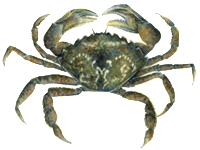| Home |
| Who We Are |
| Gallery |
| Fisheries |
| LRMP |
| Papers |
| Reference |
| Contact Us |
|
|
|
Papers>Introduced Exotic Species> We are still largely unable to account for the economic and biological damage wreaked by exotic invaders. Marine conservation biologists have reported that:
Green Crab
Green crabs in ballast water first reached San Francisco Bay, CA, in 1989. By 1997, they had reached Coos Bay, WA, and just this year was found in Vancouver Island's Barkley Sound. Green crabs are a potential threat to BC oysters and clams, and may prey on young Dungeness and red rock crabs. Conservation biologists also had this to say about green crabs: "The introduction and spread of Carcinus maenas has the potential to change coastal communities over much of western North America." Health Consequences We're also woefully ignorant about the potential health consequences of introduced species. In general:
|
